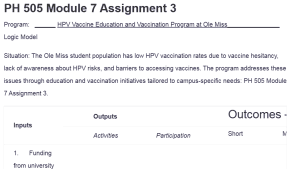PH 505 Module 7 Assignment 3
Program: ______ HPV Vaccine Education and Vaccination Program at Ole Miss_______________ Logic Model
Situation: The Ole Miss student population has low HPV vaccination rates due to vaccine hesitancy, lack of awareness about HPV risks, and barriers to accessing vaccines. The program addresses these issues through education and vaccination initiatives tailored to campus-specific needs: PH 505 Module 7 Assignment 3.
| Inputs | Outputs |
Outcomes — Impact |
||||||
| Activities | Participation |
Short |
Medium |
Long |
||||
| 1. Funding from university resources and external healthcare partnerships (e.g., grants, state health initiatives).
2. Personnel, including student health center staff, faculty advocates, and trained student ambassadors. 3. Evidence-based educational materials and tools addressing HPV myths, risks, and benefits (Bednarczyk, 2019). 4. Facilities such as student health centers and temporary vaccination clinics in high-traffic areas of the campus. 5. Collaboration with local healthcare providers for vaccine supply and administration. 6. Technological support for data collection, promotional campaigns, and appointment scheduling. |
|
|
|
|
|
|||
| Assumptions | External Factors | |
| 1. Students will respond positively to peer-led outreach and evidence-based educational materials.
2. Adequate vaccine supply and funding will remain consistent throughout the program duration. 3. Campus health services will continue to support program logistics and data collection. |
1. Community-level vaccine hesitancy or misinformation that may influence students’ perceptions.
2. Adherence to state and federal health regulations regarding vaccination mandates and program delivery. 3. Economic factors affecting funding availability and accessibility of vaccines for students. |
References
Bednarczyk, R. A. (2019). Addressing HPV vaccine myths: practical information for healthcare providers. Human Vaccines & Immunotherapeutics, 15(7-8), 1628–1638. https://doi.org/10.1080/21645515.2019.1565267
Chau, J. P. C., Lo, S. H. S., Choi, K. C., Lee, V. W. Y., Lui, G. C. Y., Chan, K. M., & Lau, A. Y. L. (2020). Effects of a multidisciplinary team-led school-based human papillomavirus vaccination health-promotion programme on improving vaccine acceptance and uptake among female adolescents. Medicine, 99(37), e22072. https://doi.org/10.1097/md.0000000000022072
ORDER A PLAGIARISM-FREE PAPER HERE
We’ll write everything from scratch
Question 
Designing programs or interventions and the support for them through administrative and policy diagnosis – determine (and address) the internal administrative and internal and external policy factors that can affect the success of your intervention. The former include organizational structure, procedures, culture, and resources; the latter encompass both internal policies and funders’ requirements, oversight agency regulations, state or federal laws, or local ordinances, and unstated community policies. (20 points)

PH 505 Module 7 Assignment 3
Example: Based on the previous stages, I would begin designing my program around HPV vaccine education/vaccinations on the Ole Miss campus.
- Please include your mock program’s logic model